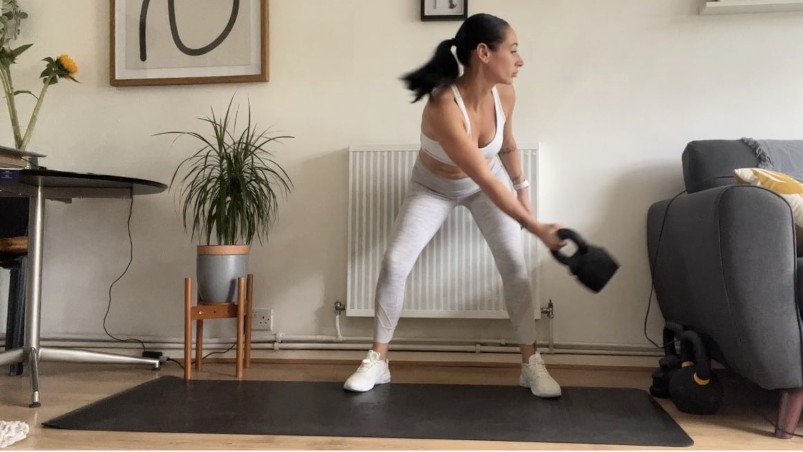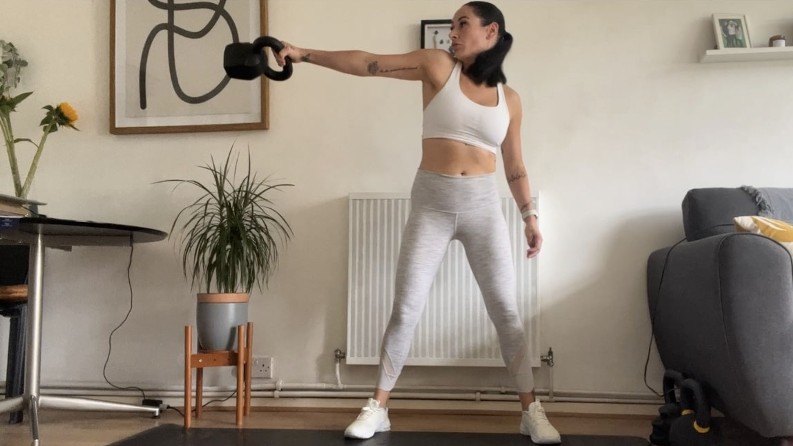
We’ve swung high and low during kettlebell challenges at Tom’s Guide, but lateral kettlebell swings are the toughest — so I went sideways for 90 reps every day for one week.
This advanced kettlebell exercise takes the regular Russian swing sideways instead of forward and back. But the variation requires existing kettlebell skills before you try it, so we recommend learning how to do a kettlebell swing and how to hold a kettlebell properly, or you risk taking yourself out by the knees.
I added this kettlebell exercise into my existing exercise regime for one week only as a finisher, but more on that shortly. Here’s what happened when I did 90 lateral swings every day for a week and how my abs are feeling now.
How to do lateral kettlebell swings
Here’s how:



- Stand with feet slightly wider than shoulder-width apart and the kettlebell between your legs
- Softly bend your knees, then lock them in place. Engage your core muscles and set your shoulders back and down with a flat back
- Grip the weight with your right hand, with a straight arm, slightly swing it to the left, then drive the kettlebell across to the right
- As the kettlebell travels upward, stand tall and squeeze your glutes
- At shoulder height, control the weight down across your body to just below and outside the left knee. Create a straight diagonal line from the kettlebell to the shoulder joint
- Remember to straighten your legs as the weight travels up, hinge at the hips and re-bend the knees on the way down.
Side on, this move looks like a single-arm golf swing — golfers, take note.
I did 90 lateral kettlebell swings every day for a week — here's what happened
Here are my results.
Day 1
Oh boy, this one puts your core through the wringer. With 45 reps to achieve per side, I adopted an EMOM format — every minute on the minute. By splitting reps up this way, I could manage 8-10 reps per side within the minute and 15 seconds of rest spare before the next round.
Get instant access to breaking news, the hottest reviews, great deals and helpful tips.
I used a 12kg kettlebell for this challenge, much lighter than I’d use for swings, but this is no ordinary exercise. Lateral swings are unilateral, meaning you’ll train one side of your body at a time, plus you’re using one arm and crossing over the body instead.
The current research has shown that unilateral resistance training could elicit cross-education — when untrained muscles are indirectly stimulated by a movement, meaning you could train weaker or underused muscles.
Days 2 & 3
It’s easy to hurt your lower back during lateral swings. The move requires significant core activation. I focused on bracing my stomach and squeezing my shoulder blades together, lifting my chest and flattening my back. Hunching during lateral swings is a fast way to hurt yourself.
During lateral swings, the bell crosses the body and rotates the midsection. The gentle twisting motion switched on my waist and torched my abs and oblique muscles — the muscles that run from the ribs to the pelvis and help the torso flex and rotate, among other jobs. Already, this was proving pretty challenging; only four days remaining. Sigh.

Days 4 & 5
I rarely do lateral swings but found them surprisingly comfortable despite being killer on my core muscles. And I didn’t need to lift the bell above my head like during American kettlebell swings — thankfully.
However, I did notice a tendency to shrug my shoulder up toward my ear during the swing (see photo above) and had to focus on relaxing my shoulder back down and turning my chest forward more. I encourage anyone who is unsure of their form during any move to take photos or perform them in the mirror to check your alignment.
Many people focus on the six-pack muscles called the rectus abdominis when training their abs but core muscles are complex and form from internal (deeper) and external (superficial) muscles. This exercise is a great way to move the body in a different direction, hitting muscles you might not normally train or even notice. I felt my waist muscles switching on, and it was rare for my obliques to feel this targeted.
Is this my new best ab exercise?
Days 6 & 7
On day six, I decided to add weight. Feeling completely comfortable with the movement pattern, I chucked a few more kilos. I continued to do an engagement check-in, scanning my body from head to toe to ensure I wasn’t forgetting to switch muscle groups on (I’m guilty of lacking glute engagement) and noticed my lower back starting to fatigue.
Despite the change in direction, your hips, glutes and core are still crucial during lateral kettlebell swings and your arms and back should never take on the full weight. By day seven, my shoulders, arms, core, glutes and hamstrings were on fire — in the best way possible — but it was absolutely time to round things up.
Verdict
I’m glad I used the EMOM for this challenge because it held me accountable to myself, the reps and a time cap. By keeping to set reps and giving myself dedicated rest, I could challenge myself and measure my progress throughout the week without overdoing it or rushing.
If you plan to try lateral kettlebell swings, I strongly recommend getting comfortable with Russian kettlebell swings beforehand and learning about engaging your core, and why it matters. You hear the term “engage your core” all the time in fitness, but how many people know what that means? I always tell clients to brace themselves for a punch in the stomach, contracting the muscles while still breathing into that space — try to avoid restricting your breath.
The research shows that regular kettlebell training improves explosive strength and power, so it’s worth the payoff to practice.
More from Tom's Guide
- I did 100 kettlebell swings a day — here’s what happened
- 7 best kettlebell ab exercises for strengthening your core muscles
- Forget sit-ups, this no equipment ab workout blasts your deep core.

Sam Hopes is a level 3 qualified trainer, a level 2 Reiki practitioner and fitness editor at Tom's Guide. She is also currently undertaking her Yoga For Athletes training course.
Sam has written for various fitness brands and websites over the years and has experience across brands at Future, such as Live Science, Fit&Well, Coach, and T3.
Having coached at fitness studios like F45 and Virgin Active and personal trained, Sam now primarily teaches outdoor bootcamps, bodyweight, calisthenics and kettlebells.
She also coaches mobility and flexibility classes several times a week and believes that true strength comes from a holistic approach to training your body.
Sam has completed two mixed doubles Hyrox competitions in London and the Netherlands and finished her first doubles attempt in 1:11.
